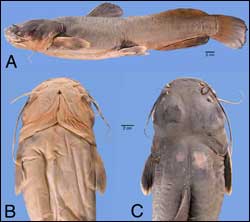Researchers identify new catfish family

Lacantunia enigmatica, Holotype specimen ECO-SC 3859, 427 mm SL. A. Lateral view. B. Ventral view. C. Dorsal view.
A team of researchers from Mexico and the United States has identified a new family of catfish in the state of Chiapas, Mexico. The paper detailing the discovery has been published in Zootaxa, an online scientific journal.
They’ve named the new family Lacantuniidae and named the species Lacantunia enigmatica. It becomes the 37th family of catfishes, a diverse group of fish found around the world.
Discovery of new families of living vertebrates is rare; in ichthyology there have been just two new families discovered in the past 60 years: the coelacanth in 1938 and the megamouth shark in 1983.
The researchers are Dr. Rocio Rodiles-Hernandez of the Colegio de la Frontera Sur, Dr. Dean Hendrickson and Dr. Julian Humphries of The University of Texas at Austin and Dr. John Lundberg of the Academy of Natural Sciences of Philadelphia.
Thorough anatomical studies of the fish document its status as a new family and show that the fish is the only member of an ancient group that may have arisen while dinosaurs roamed the Earth. The fish’s skeleton was scanned by high-resolution computer tomographic equipment at The University of Texas at Austin. “To most people it’s just a catfish, and externally it looks a lot like an ictalurid, the family to which all North American freshwater catfishes belong,” Hendrickson said. “But once we got into the skeleton, we started seeing all these weird things.”
A barbel (the part that resembles a cat’s whisker) is articulated differently from that of an ictalurid. There also are differences in the bone structure of the skull and in the shape of the air bladder. “The ictalurids all have these big jaw muscles that come up over the top and anchor on top of the head,” Hendrickson said. “This has a very narrow cranium and the muscles anchor to the sides of the bone instead of coming up on top. That and a number of other characters clearly indicate it has nothing to do with ictalurids.”
The animal and plant life of Mesoamerica is exceptionally diverse with distinct origins from North America, South America and adjacent oceans. They said Lacantunia enigmatica appears not to fit any of those patterns and thus the name of the species reflects the mystery surrounding its origins and relationships.
The generic name of the fish reflects its distribution in the Río Lacantún drainage, flowing through the Montes Azules and Selva Lacandona Biosphere Reserves in México into that country’s largest river, the Río Usumacinta. The fish is relatively rare in that the researchers have had a hard time finding many specimens. They collected just one specimen in a recent five-day expedition. The researchers are concerned about the fish’s habitat, which is threatened by exploitation of the forests and possible damming of the rivers it lives in.
Research has been supported by the American Association for the Advancement of Science’s Women’s International Science Collaboration program, CONACYT-Mexico, the National Science Foundation’s All Catfish Species Inventory Project, the Philadelphia Academy of Natural Sciences, the Texas Memorial Museum at The University of Texas at Austin and El Colegio de la Frontera Sur.
The complete publication can be found at www.mapress.com/zootaxa/2005f/zt01000.pdf [PDF].
Media Contact
All latest news from the category: Life Sciences and Chemistry
Articles and reports from the Life Sciences and chemistry area deal with applied and basic research into modern biology, chemistry and human medicine.
Valuable information can be found on a range of life sciences fields including bacteriology, biochemistry, bionics, bioinformatics, biophysics, biotechnology, genetics, geobotany, human biology, marine biology, microbiology, molecular biology, cellular biology, zoology, bioinorganic chemistry, microchemistry and environmental chemistry.
Newest articles

Superradiant atoms could push the boundaries of how precisely time can be measured
Superradiant atoms can help us measure time more precisely than ever. In a new study, researchers from the University of Copenhagen present a new method for measuring the time interval,…

Ion thermoelectric conversion devices for near room temperature
The electrode sheet of the thermoelectric device consists of ionic hydrogel, which is sandwiched between the electrodes to form, and the Prussian blue on the electrode undergoes a redox reaction…

Zap Energy achieves 37-million-degree temperatures in a compact device
New publication reports record electron temperatures for a small-scale, sheared-flow-stabilized Z-pinch fusion device. In the nine decades since humans first produced fusion reactions, only a few fusion technologies have demonstrated…





















